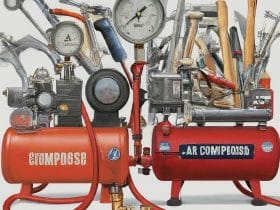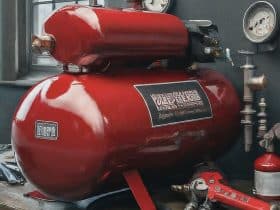Ever imagine this? You squeeze the trigger on your favorite nail gun, but instead of a satisfying “bam,” you get a sputter and a hiss. Or, you’re giving your car a shiny new paint job, and instead of a smooth, perfect finish, you end up with a mess full of holes. The reason? Tiny drops of water hiding in your air compressor, causing problems for your projects.
But don’t worry, DIY warrior or professional painter! Just like a superhero needs a toolbox full of helpful things, your air compressor needs a plan to get rid of moisture. Because let’s be honest, water shouldn’t be part of the compressed air party. Here’s how to remove moisture from air compressor and keep your compressor dry and your projects looking great.
Table of Contents
Why Moisture Matters: A Troublemaker Exposed
Think of moisture as the annoying prankster in your air compressor. It leads to a bunch of problems:
- Rust City: Moisture loves to play connect-the-dots on the inside of your tank and pipes, leaving behind a rusty mess. This weakens the whole system and can lead to leaks, putting your compressor’s health at risk.
- Tool Time Trouble: Tools powered by moist air becomes grumpy and don’t work well. Imagine a race car fueled with dirty pond water – that’s what happens when moisture clogs up your tools.
- Frozen Fury: If you work in cold places, moisture can freeze and block your air lines, stopping everything from working. Think of it as a tiny plumbing nightmare.
- Contamination Chaos: If you’re using compressed air for delicate tasks like painting cars or food processing, even a little moisture can be a disaster. It’s like sprinkling unwanted sprinkles on your masterpiece!
Moisture Removal: Your Weapon Chest
Now that we’ve identified the enemy, let’s explore your chest full of moisture-removal weapons:
- The Drain Dodger Destroyer: This is your basic but important weapon. Most air compressors come with a drain valve at the bottom of the tank. It’s like the oil pan of your car – gotta empty it regularly! After each use, and more often in humid places, open this valve and let the moisture out.
- The Water Separator Filter: Think of this as a mini dam for moisture. Install it inline with your system, it traps water droplets before they can cause trouble. It’s like having a built-in filter catching pebbles before they clog your garden hose. Remember to empty the filter’s bowl regularly – don’t let the caught moisture become a problem!
- The Refrigerated Air Dryer Defender: Need a more powerful weapon? Enter the refrigerated air dryer. It works by chilling the compressed air, forcing a lot of moisture to condense and separate, kind of like how a cold drink sweats on a hot day. This is a great option for removing larger amounts of moisture.
- The Desiccant Air Dryer Doomsayer (for Extreme Situations): If you need your air super dry, with no moisture at all, then the desiccant air dryer is your ultimate doomsayer for moisture. It uses special materials (desiccants) that soak up moisture like a sponge. Think of it as a super-powered version of the silica packets you find in new shoes. Desiccants may need periodic replacement or rebuilding, but they’re the ultimate weapon for ultra-dry air.
Choosing Your Weapon Wisely: Matching Needs to Solutions
The best weapon for you depends on how dry you need the air to be and your budget. Here’s a quick guide:
- Basic warriors: For simple moisture removal and basic tool use, draining the tank and a water separator filter might be enough.
- Moisture Fighter: If you’re dealing with moderate moisture levels, or need drier air for tasks like painting, a refrigerated air dryer is a worthy fighter.
- Desiccant Air Dryer Destroyer: When only the driest of air will do, for processes that can’t tolerate any moisture, the desiccant air dryer is the ultimate destroyer.
Extra Tips and Tricks: How To Remove Moisture From Air Compressor
Here’s a few extra pointers in your quest for dry air:
- Location, Location, Location: Try placing your compressor in a cool, dry area. Otherwise, It’s like putting your refrigerator in a hot garage – the compressor will have to work harder to cool the air, which means more moisture trouble.
- Think Like Water – Sloping Your Lines: Imagine you’re a water droplet – you like flowing downhill, right? Slope your air lines accordingly, away from the compressor. This lets condensation flow naturally towards drain points.
- The Aftercooler Advantage: An aftercooler is like an extra refrigerator right after the compressor. It cools hot air quickly, forcing condensation to happen before it reaches your other equipment.
The Importance of Routines – Preventative Care
Think of your compressor like your car – it needs regular attention to keep things running smoothly:
- Daily Draining: Don’t skip this, especially in humid climates! It’s the easiest way to prevent problems before they start.
- Filter Checks: Inspect your water separator filter and replace it if dirty. A clogged filter is like trying to breathe through a muddy rag.
- Yearly Tune-up: Depending on usage, a full inspection by a pro can catch problems early. Think of it as your compressor’s version of a doctor’s checkup.
A Final Word of Encouragement
You might be thinking, “All this for some clean air? Seems complicated.” True, it takes a bit of effort, but think of your time investment this way: Would you rather spend a little time on maintenance now or deal with a rusty, broken compressor and messed-up projects later? Plus, maintaining your compressor properly means it’ll last longer, saving you money in the long run. So, put on your hero cape, grab your toolbox, and declare war on those pesky moisture invaders!
Think of removing moisture from your air compressor as an essential form of tool maintenance. After all, your tools are an investment in your projects. So now, as you have gained knowledge about how to remove moisture from air compressor, keep your tools (and your precious projects) happy and healthy by making the fight against moisture a top priority. It’s time to show those tiny water droplets who’s boss!
FAQs
Q 1: Why is it so important to remove moisture from my air compressor?
Answer: Moisture leads to rust, tool damage, potential freezing issues, and can ruin projects that require clean, dry air. It compromises the health of your compressor and the quality of your work.
Q 2: I’m on a budget. What’s the most basic thing I can do to fight moisture?
Answer: Regularly draining your compressor’s tank is the absolute minimum. It’s free, easy, and crucial, especially in humid environments.
Q 3: How often should I drain the tank?
Answer: Ideally, drain it after every use. If you live in a very humid area, drain it more frequently throughout the day.
Q 4: What’s the difference between a refrigerated air dryer and a desiccant air dryer?
Answer: A refrigerated air dryer chills the air to remove moisture, while a desiccant dryer uses special moisture-absorbing materials. Desiccant dryers can produce extremely dry air, but may require periodic replacement of the materials.
Q 5: Is there anything else I can do besides the main moisture removal methods?
Answer: Yes! Place your compressor in a cool, dry area if possible. Slope your air lines downwards away from the compressor for natural drainage, and consider an after-cooler for pre-cooling the air.








Leave a Reply